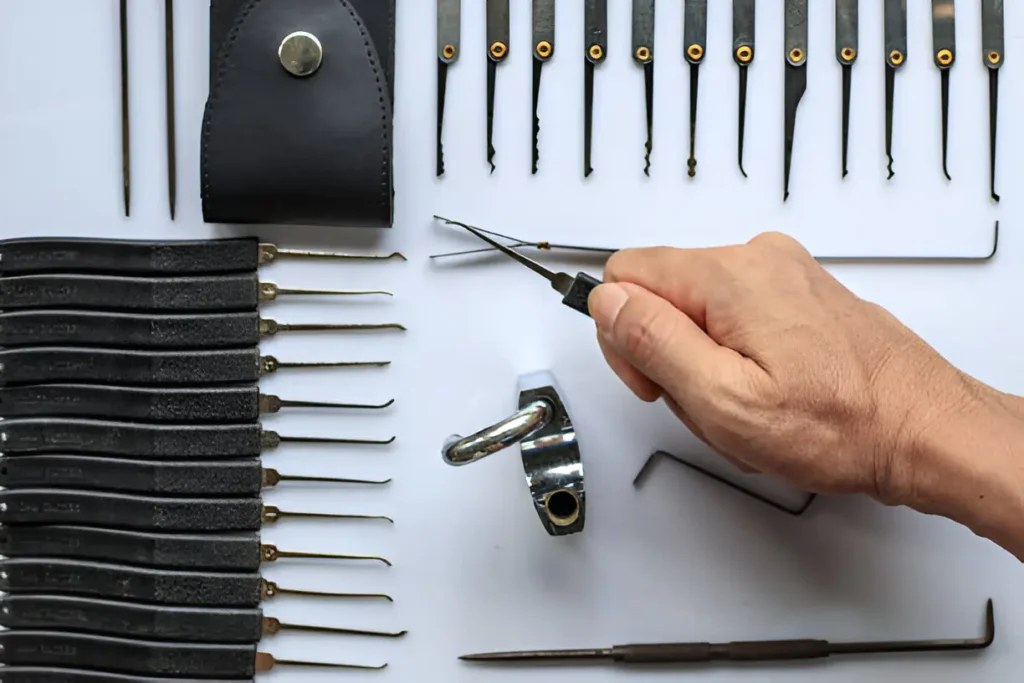In the vast realm of home security, understanding the nuances of lock picking can play a pivotal role in ensuring the safety of your residence. However, it must be noted that the intention here is to guide enthusiasts or professionals in the legal field of locksmithing. It is of utmost importance to comprehend and respect the legal boundaries concerning lock picking.
The art of lock picking has been practised for centuries, primarily serving locksmiths in their trade. With the right tools, knowledge, and skills, a locksmith can gain access to locks without the original key. For professionals and hobbyists alike, selecting an appropriate lock picking kit is crucial in developing their skill set and providing a deeper understanding of how locks work.
Understanding Lock Picking Kits
Before one can delve into the selection of a lock picking kit, it is essential to understand what these kits typically include. A standard lock picking kit comes with an assortment of tools designed to manipulate the components of a lock to unlock it without causing damage. These kits usually contain an array of picks, tension wrenches, and sometimes additional accessories like practice locks or instruction manuals.
Each tool within a lock picking kit is crafted with a specific purpose in mind. Picks are designed according to various pin configurations inside locks, while tension wrenches are used to apply the necessary turning force to the lock cylinder. The combination of these tools allows a lock picker to simulate the action of the correct key.
Key Factors to Consider
When choosing a lock picking kit, various factors must be taken into consideration. Quality is paramount, as poorly made tools can break easily and fail to manipulate lock mechanisms effectively. Durability is also key; a well-constructed kit can withstand repeated use and provide a more reliable experience.
Comprehensiveness is another important aspect. A more extensive kit with a variety of tools can accommodate diverse types of locks, making it a valuable resource for learning and practice. Furthermore, the experience level of the user should be accounted for; beginners may benefit from simpler, more user-friendly kits, while experts may seek advanced options with specialised tools.
Materials and Craftsmanship
The material of the lock picking tools is a critical consideration. High-quality stainless steel or titanium is often the preference for durability and precision. Additionally, the craftsmanship of the tools – such as the handles and the finishing – can significantly affect their usability and comfort.
It is crucial to select a kit that provides a good grip and ergonomic design, especially for users who spend extended periods practising or in professional settings. The feedback a tool provides can be vital in developing tactile skills necessary for successful lock picking.
Legal Implications and Ethical Considerations
As thrilling as the world of lock picking may be, one must always be attentive to the legal and ethical implications. Owning a lock picking kit carries the responsibility of using it in a legal and moral way. In many regions, possession of lock picking tools is subject to legal restrictions, and their use is allowed strictly in legitimate circumstances, such as by professional locksmiths or for the purpose of personal skill development with proper permissions.
It is incumbent upon each individual to research and comply with their local laws regarding lock picking tools. Taking such precautions not only helps avoid potential legal entanglements but also maintains the integrity of the lock picking community.
Practical Application and Practice
For those learning the craft, practising with a lock picking kit can be an invaluable experience. Having a variety of practice locks on which to work can enhance understanding of different mechanisms and lock styles. By honing these skills in a controlled and legal setting, individuals can improve their proficiency without compromising security.
Professional locksmiths often use lock picking kits as a means of non-destructive entry, allowing them to assist clients who are locked out without causing damage to the lock or door. Similarly, hobbyists interested in the mechanics of locks can find lock picking a rewarding and educative pursuit.
Finding the Right Kit
To choose the right lock picking kit, start by assessing your own needs and skills. For beginners, picking a kit with a set of basic tools and a guidebook is advisable. Those with more experience may look for kits with a wider range of pick styles and tension tools to suit different types of locks. In both cases, quality should not be compromised.
Seeking out reputable suppliers, such as Pick My Lock, can ensure that you obtain a kit that is both functional and durable. A trustworthy supplier will offer kits that cater to various skill levels and provide the necessary information to make an informed decision.
Conclusion
In conclusion, a lock picking kit is an instrumental part of the toolkit for both locksmith professionals and enthusiasts. When choosing the right kit, one should consider quality, durability, variety, material, craftsmanship, and legal implications. Finding a reputable supplier will aid in procuring a kit that best suits your requirements and skill level.
Whether you are embarking on a journey to become a skilled locksmith or simply curious about the inner workings of locks, the appropriate lock picking kit can open doors to a greater understanding of security and lock mechanics. With the right kit and a responsible approach, you can enhance your skills in a legal, ethical, and secure manner.
Remember to always practise responsibly and within the bounds of the law to ensure the continued respect for the craft of lock picking.
Read more: Unfolding Possibilities: The Rise of 2-in-1 Laptops in a Mobile World – Dimensions Script
Marketing Tactics That Actually Work


